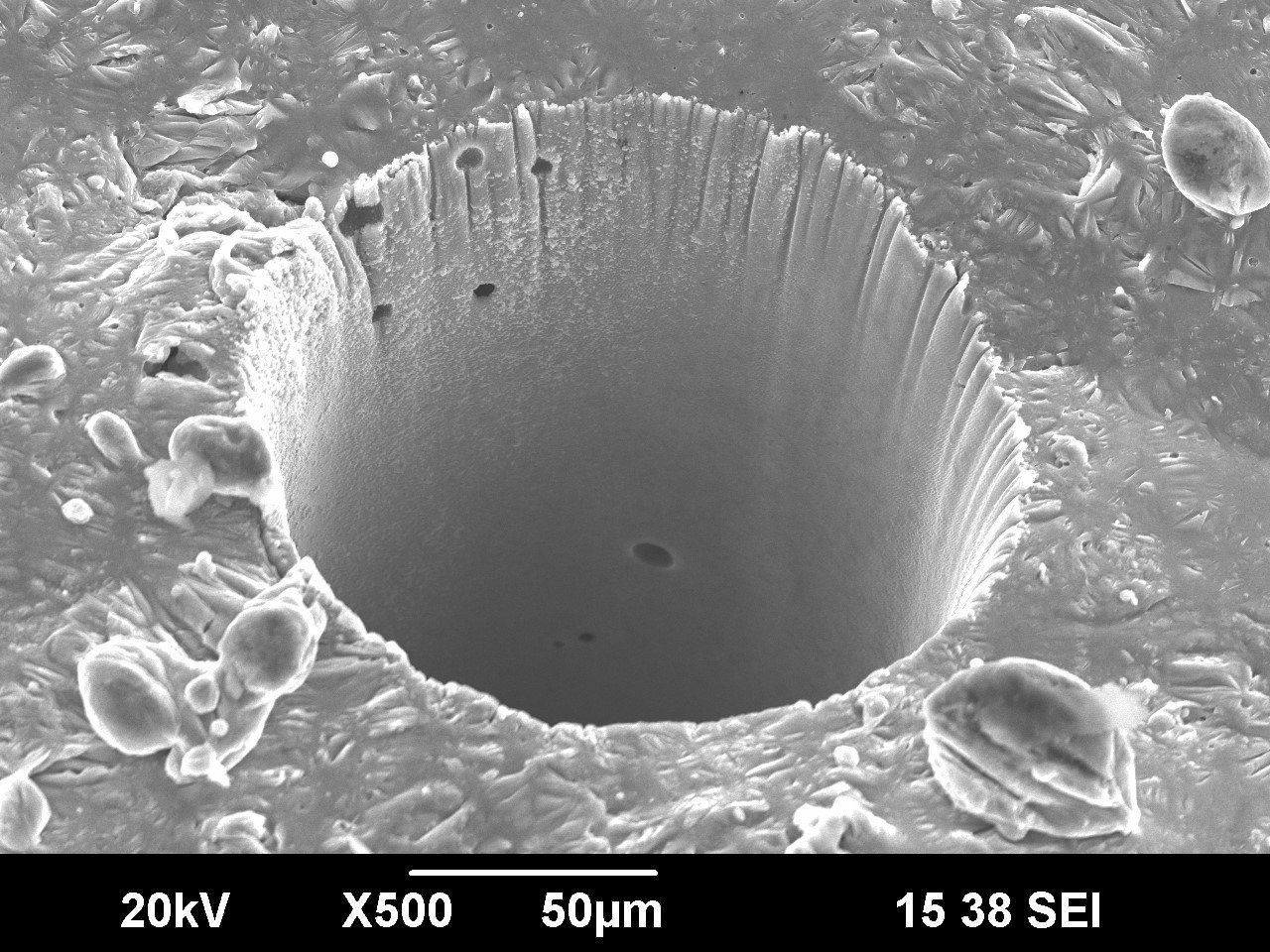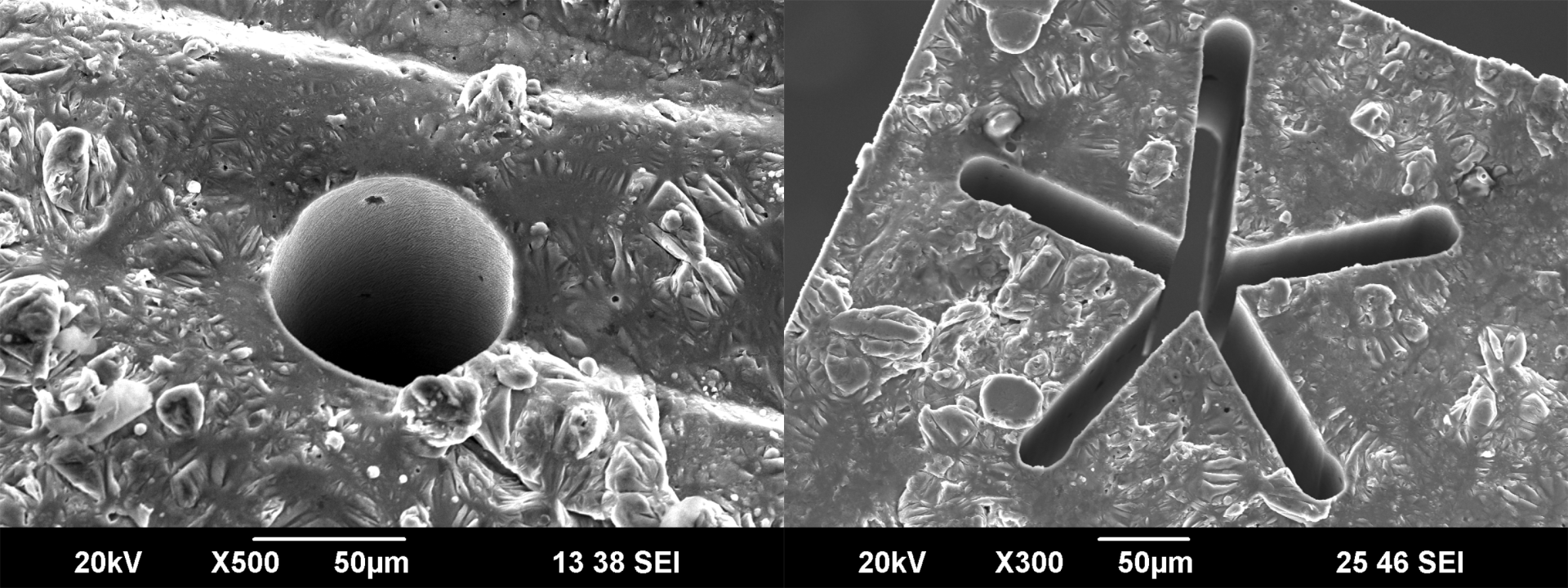Post-processing of additively manufactured components
Precise post-processing with ultrashort pulse lasers
The ultrashort pulse laser as a guarantee for precision
The process of additive manufacturing opens up a completely new freedom in the design of components. Despite the remarkable progress in terms of quality, costs and production times, additively manufactured components usually do not get by without further finishing. The use of ultrashort pulse lasers for micromachining of additively manufactured components allows the advantages of both methods, freedom of design and precision, to be combined.
Additive manufactured aluminum
For our investigations, samples of the aluminum material AlSi10Mg
were prepared in an additive manner. The surface of the samples was very irregular and rough, as can be seen in the SEM-image. There are particles with diameters of several 10 µm and irregularities in the order of magnitude of up to 10 µm. Such an irregular surface is a challenging starting point for precise post-processing with the ultrashort pulse laser.
Microdrilling of additively manufactured components
The challenge in drilling additive produced AlSi10Mg is the irregular surface of the available material and its porosity. These irregularities can negatively influence the drilling process, so that the quality of the drilling cannot be guaranteed. Quality-reducing characteristics would be, for example, the occurrence of side channels or fraying of the hole edge.
Our experiments on microdrilling of additive-manufactured aluminum show that precise drill holes can be produced despite the inhomogeneities of the material. Both round holes and specially shaped holes are possible. The SEM image shows the entry of such a micro hole. On this side the laser hits the material. Despite particle buildup on the surface, a sharp-edged hole entry was created. Only the grooves typical for a laser process are visible in the upper part of the hole. The diameter is about 150 µm.
Our experiments on microdrilling of additive-manufactured aluminum show that precise drill holes can be produced despite the inhomogeneities of the material. Both round holes and specially shaped holes are possible. The SEM image shows the entry of such a micro hole. On this side the laser hits the material. Despite particle buildup on the surface, a sharp-edged hole entry was created. Only the grooves typical for a laser process are visible in the upper part of the hole. The diameter is about 150 µm.
The following REM image shows the laser exit of the hole. Here the high processing quality with the ultrashort pulse laser becomes particularly clear. The hole exit is sharp-edged and the roughness of the hole wall is only a few 100 nm. Any pores in the material with a diameter of 1 µm to 10 µm were also cut cleanly and did not negatively affect the drilling process. The quality usually achievable with the ultra-short pulse laser can therefore also be implemented in material produced with additives.
The SEM images shown below illustrate once again the precision that can be achieved. Close-ups of hole exits are shown. On the wall of the hole laser induced structures in the range of less than 1 µm can be seen, which are a typical feature of laser drilled holes. Furthermore, the sharply cut pores of the material can be seen.
The innovative potential of the ultrashort pulse laser lies in the particularly small hole diameters and special hole geometries that can be produced with this processing method. Despite inhomogeneities on the material surface in the order of several 10 µm, precise holes with similar diameters can be drilled. The lower SEM image shows a micro hole with a diameter of 50 µm. Special hole shapes such as a 5-arm star with 20 µm wide arms can also be produced without any problems.
These initial investigations prove that additively manufactured components can be drilled precisely with the ultrashort pulse laser. Further machining processes are presented in the following.
Surface post-processing
With the ultrashort pulse laser, surfaces can be porst-processed in many different ways. Layer-by-layer ablation produces engravings, rough surfaces can be smoothed or components can be marked by a laser-induced color change.
In layer-by-layer ablation, the laser beam is moved in parallel lines at a defined distance over the workpiece to create surfaces. By repeating the process several times, 2.5D structures or engravings can be created. The rough surface of additively produced components is a particular challenge. With grid-shaped ablation, irregularities can also propagate into the depths.
A comparison between the original surface and laser-structured surface is shown in the following picture. The untreated surface is very irregular with height differences of maximum 70 µm. Particles of the order of 20 to 50 µm adhere to the surface. Not visible on the light microscope image are long-wave height differences of up to 30 µm over a distance of several 100 µm. Such irregularities can propagate into the depth during post-processing. Square pockets were ablated into this material and the resulting surfaces were examined.
In layer-by-layer ablation, the laser beam is moved in parallel lines at a defined distance over the workpiece to create surfaces. By repeating the process several times, 2.5D structures or engravings can be created. The rough surface of additively produced components is a particular challenge. With grid-shaped ablation, irregularities can also propagate into the depths.
A comparison between the original surface and laser-structured surface is shown in the following picture. The untreated surface is very irregular with height differences of maximum 70 µm. Particles of the order of 20 to 50 µm adhere to the surface. Not visible on the light microscope image are long-wave height differences of up to 30 µm over a distance of several 100 µm. Such irregularities can propagate into the depth during post-processing. Square pockets were ablated into this material and the resulting surfaces were examined.
On the right side of the image you can see such a laser structured surface. Adhering particles could be completely removed from the surface. The roughness of the surface was thus significantly reduced. Long-wave height differences continued into the depth despite laser structuring, but the maximum height difference of the surface was reduced from 70 µm to 40 µm. Within the accuracy given by the long-wave height differences, the ultrashort pulse laser can thus be used to create 2.5D structures with a low roughness or to smooth surfaces.
With the ultrashort pulse laser, surfaces can not only be structured but also marked. Additive manufactured aluminum components can be reliably marked with the ultrashort pulse laser. This can be seen in the following microscope image. The lower half of the image shows the unprocessed surface, the upper half shows a marked area. The irregularities of the surface described above did not have a significant influence on the marking process. The entire marking is deep black. This can be used, for example, for marking the UDI on additively manufactured aluminum components in medical technology.
With the ultrashort pulse laser, surfaces can not only be structured but also marked. Additive manufactured aluminum components can be reliably marked with the ultrashort pulse laser. This can be seen in the following microscope image. The lower half of the image shows the unprocessed surface, the upper half shows a marked area. The irregularities of the surface described above did not have a significant influence on the marking process. The entire marking is deep black. This can be used, for example, for marking the UDI on additively manufactured aluminum components in medical technology.









